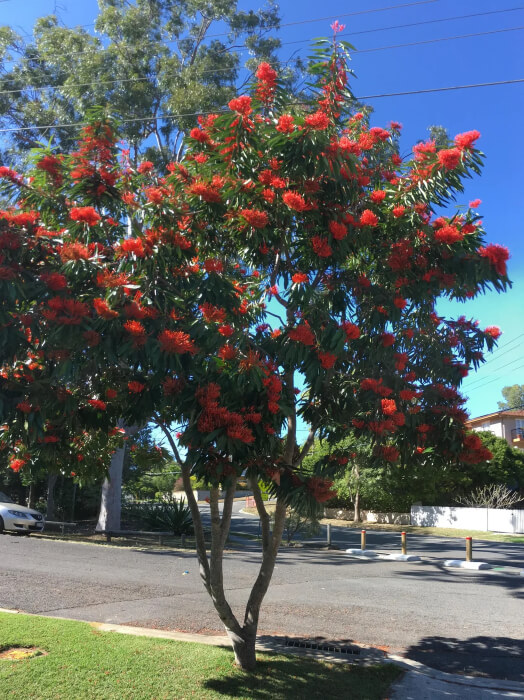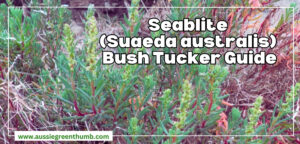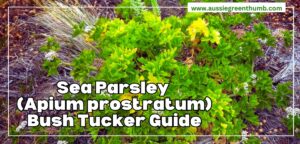The Waratah tree is one of our most ornamental Australian tropical rainforest trees that is slowly gaining much-deserved popularity within frost-free gardens across the country.
This medium-sized tree is absolutely spectacular in full flower, featuring large fiery orange to red clusters of tubular blooms from spring to early summer that adorn branch ends.
These bright red inflorescences can quickly brighten up your garden and add lovely texture and interest. Even though I’ve covered a multitude of native rainforest trees, this spectacular species has still managed to surprise me, so I am thrilled to be covering it in this article.
Here is everything you will need to know to grow and care for this showy tropical tree in your garden.
More...

Family: | Proteaceae |
|---|---|
Genus: | Alloxylon |
Species: | A. flammeum (known previously as Oreocallis wickhamii) |
Common Names: | Waratah Tree, Queensland Tree Waratah, Red Silky Oak |
Origin: | Australian Native |
Location: | Outdoor |
Type: | Tree |
Growth: | 10 to 15 metres tall, 5 to 10 metres wide |
Sun requirements: | Full sun to light shade |
Foliage Colour: | Green |
Flower Colour: | Red |
Flowering: | Spring to early summer |
Maintenance level: | Low |
Poisonous for pets: | Non-toxic to cats and dogs |
Getting to Know the Waratah Tree
Apart from its impressive flowers, this species also features shiny green elliptical leaves, a light grey bark that encompasses the tree's smooth and slender trunks, and an attractive spreading canopy that can add gorgeous silhouettes and shade to outdoor spaces.
This species adapts readily to cultivation so it can be included in almost any Australian garden that doesn’t experience harsh frosts.
Scientifically labelled Alloxylon flammeum, this species was previously labelled Oreocallis wickhamii and it can still be found under this old name in some nurseries. Its common names include the Waratah Tree, Queensland Tree Waratah and the Red Silky Oak. Its current botanical species name (flammeum) refers to its eye-catching fiery red flowers.
Part of the Proteaceae family of plants alongside Grevilleas, Waratahs and Banksias, this species is native to the Queensland tropical rainforests of north-eastern Australia.
While it can grow and flower reliably in cooler microclimates around Victoria and even Sydney, this tree does prefer the warmer regions of Australia in sub-tropical, warm temperate and Mediterranean climate zones.
Considered slow-growing, Alloxylon flammeum can reach up to 30 metres tall in its natural habitat but cultivated in gardens, it will typically reach up to 10 metres tall and 5 metres wide. Its tubular flowers are rich in nectar so the tree will naturally attract local birdlife.
This ornamental rainforest tree is most commonly used as a feature plant in gardens as it easily adds a wow factor with its bright red flowers. It can also be used as a windbreak in larger landscapes.
Growing and Propagating Waratah Tree

Source: Reddit
Propagation of this species is usually done with seeds or semi-hardened cuttings from new growth. Cuttings can be a little hard to strike and the resulting plants may develop weaker root systems than the parent plant, meaning they may need to be staked for added support as they grow.
Refer to our beginner's guide to garden staking basics for more info.


Get Your Free Guide:
Master Growing Australian Natives eBook
A Must Have Complete Guide for Every Australian Garden
Get Your Free Guide:
Master Growing Australian Natives eBook
A Must Have Complete Guide for Every Australian Garden
Cutting-grown specimens can flower within a couple of years. Seed-grown trees are typically true-to-type but can take 7 to 8 years to flower.
With this specific genus and family of natives, I would recommend establishing a young and healthy nursery plant. These tubestock plants can be easily transplanted into your garden in spring and will be less demanding overall than seedlings or cuttings.
Propagating Waratah Tree from Seeds
- Soak seeds overnight in warm water
- Prepare a seed tray by filling the cells with a quality seed-raising mix
- Sow the seeds into the mixture to a depth equal to the width of the seeds
- Mist lightly after sowing
- Keep in a bright and warm location with indirect light and keep constantly moist but never wet
- Ideal germination temperatures are between 20°C and 24°C
- Germination can take some time so be sure to stay patient and you should have healthy seedlings in no time
Propagating Alloxylon flammeum Using Cuttings
- Take semi-hardened stem cuttings from new growth in summer
- Each cutting should be around 15 cm in length
- Prepare propagation containers filled with quality, well-draining potting mix
- Dip the cut end of the stem cuttings into some rooting hormone then plant them into the mixture, watering well after planting
- Place the cuttings in a warm but sheltered location that gets bright but indirect light
- Ideal temperatures are around 24°C
- Mist regularly to keep moist but never wet
Planting Conditions for Waratah Tree
Alloxylon flammeum is one of the hardiest, most adaptable and showiest members of its genus, hence the consistent rise in its popularity. While it does need a little more attention and shelter from strong winds while young, it is overall a low-maintenance addition to gardens once established.

Source: GardensOnline
Here are the general planting and growing conditions for the tree.
Sunlight Needs
Pick a location that gets full sun to light shade daily. Full sun is preferred wherein the flowers will grow brighter and overall plant vigour will be stronger.
Best Soil to Use
The tree prefers a site with good drainage and moisture. While it can tolerate different soil types, this species does prefer loam-based soil rich in organic materials but low in phosphorus. Adequate drainage is essential to avoid wilting and rotting roots.
Here's a guide that will help you understand why plants wilt and how to avoid it.
Transplanting Waratah Tree
The red silky oak tree is very sensitive to root disturbances once established so it is important to choose your planting site well to avoid having to transplant the tree again. Try to only transplant a nursery plant once then leave it to grow in that location moving forward.
Caring for Waratah Tree
Once established, the waratah tree is tolerant of moderate frosts and drought. Overly dry conditions can lead to less flowering but once the rains return or you increase the watering frequency, the tree should return to its usual prolific flowering in spring to early summer.
Here are the basic care requirements for Queensland Tree Waratah.
Water Needs
Once established, this species will not require much supplemental watering with typical rainfall. It will need extra water in dry spells and while young until matured which takes around 1 to 2 years. In warmer months if rainfall is insufficient, it will require regular deep watering.
Fertilising Waratah Tree
While it may not be necessary in fertile soil, the waratah tree can benefit from some fertilisation. Feed with a fertiliser low in phosphorus or a specific native plant fertiliser in spring to encourage prolific flowering and to maintain plant vigour. Blood and bone will also work well.
Mulching
Add a decent layer of organic mulch around the base of the tree in dry spells to help with adequate moisture retention.
Pruning Needs
Prune your tree into shape as it grows to maintain a dense canopy and a bushier habit overall. It is best to prune annually to bi-annually using sharp and sterilised pruning shears or a pole-based pruning saw. Prune around the main trunk to help the tree develop its main bole support trunk. If left to grow naturally, the plant will grow as more of a large shrub.
Waratah Tree Pests, Problems and Diseases
Overall, this species has no major pest or disease issues of note. Having adapted to many of our endemic conditions, it has become a very hardy and reliable species across the continent.
Here are some problems it could experience in poorer conditions.
Yellowing New Leaves
This should indicate that the tree is not producing enough chlorophyll from an iron deficiency. You can treat your tree with some iron sulphate which is available from nurseries to rectify the issue.
Root Rot
If the tree is overwatered or the soil is not draining well enough, the plant can develop root rotting issues. This fungal disease can severely damage young plants so it is essential to avoid overwatering and always plant in well-draining soil.
Waratah Tree Frequently Asked Questions

Source: Alchetron
Where is the best place to plant a waratah tree?
Unlike normal Waratahs that enjoy the morning sun with shaded roots, the waratah tree prefers a spot with full sun to light shade. It also enjoys good soil moisture and rich organic matter in the soil. It will need some protection from strong winds while young or can be staked for added support.
Is it the Queensland tree waratah or red silky oak?
The species, Alloxylon flammeum, is commonly known as both the Queensland tree waratah and red silky oak. Both names are considered acceptable for the tree. The Grevillea banksii shrub is also known as red silky oak but this is a far less common name for it than it is for the waratah tree.
Do waratahs grow in Queensland?
The tree waratah species is a spectacular large flowering tree that occurs in the tropical rainforests of North Queensland. While it can grow up to 30 metres tall there, it will usually only reach up to 10 metres in cultivation, making it an excellent pick for larger landscapes that need a feature.
How long does a waratah tree last?
Being a perennial, this tree can last for a very long time in healthy conditions. Its average lifespan is usually over 30 years but it can live for far longer.
How long do waratah tree flowers last?
Cut flowers can last for about 2 to 3 weeks. The tree itself will flower from spring to early summer, offering gardens about 4 months of prolific clusters of red fiery blooms at the tips of branches.
How fast do waratah trees grow?
The Queensland tree waratah (Alloxylon flammeum) is considered a slow-growing species. It can take 7 to 8 years to flower and only reaches around 10 metres tall when cultivated in gardens.
If you’re also interested in learning more about growing traditional Waratahs (Telopea), then be sure to refer to our informative guide below for more:
Enjoy One of Our Most Showy Rainforest Species with the Waratah Tree
I hope I’ve managed to convey just how beautiful and useful this spectacular rainforest species can be within gardens. The waratah tree takes its genus to new heights with its massive clusters of fiery red flowers and its luscious evergreen foliage.
If you’re looking for your next medium-sized ornamental tree, the Queensland tree waratah is the perfect pick, especially if you have the space to let it grow and create wonderful silhouettes in the garden.
Enjoy one of our showiest and most adaptable rainforest tree species with the remarkable waratah tree.
Published on June 17, 2023 by Lorri Hopkins
Last Updated on February 23, 2024




